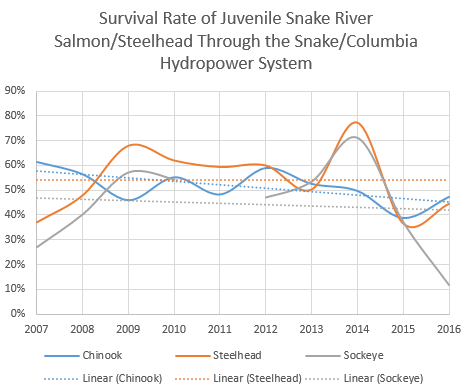BPA fails to give Snake/Columbia dams proper credit
Posted /Uncategorized
A new report published by Oregon State University (OSU) and funded by the Bonneville Power Administration (BPA) and the National Oceanic and Atmospheric Administration (NOAA), blames ocean conditions in 2015 for the poor Chinook salmon runs that are predicted by Pacific Northwest fisheries managers in 2017. Ocean conditions, or the Pacific Decadal Oscillation (PDO), are NOAA’s newest scapegoat in explaining salmon mortality. In reality, the life and death struggles experienced by the salmon and steelhead returning this year started long before they entered the Pacific Ocean.
The April 2016 report “Survival Estimates for the Passage of Spring-Migrating Juvenile Salmonids through Snake and Columbia River Dams and Reservoirs, 2015 ”, which was prepared by NOAA for BPA, showed just how bad it really was. The data, graphed below, shows only 39% of juvenile Chinook salmon, 36% of steelhead, and 37% of sockeye salmon surviving the downstream journey from their place of birth in Idaho past 8 dams on the Snake and Columbia Rivers. For comparison, survival had been averaging 49% for Chinook and 45% for steelhead. The paper also interestingly points out that fish survival has remained relatively stable since 1999, which is contrary to the propaganda fed to the media by BPA and the Army Corps of Engineers about the “great gains” made (with our tax and rate payer dollars) in fish passage and recovery. Juveniles faced high water temperatures in the slow moving reservoirs, and the reservoirs prolonged the annual migration to the ocean, meaning they arrived after the ocean had undergone seasonal warming. Prior to dam construction, juveniles arrived in the ocean much earlier when it was still cool, which increased their survival.
The funding for the OSU paper is peculiar. BPA is the federal agency in charge of operating the hydropower system that has forced wild salmon and steelhead to the brink of extinction. NOAA is the federal agency in charge of recovering them. BPA provides the funding for many of the research projects undertaken by NOAA. I heard the author David James Duncan describe this relationship as something akin to having meth cooks running the meth addiction recovery program.
I expect we will see more finger pointing at the ocean this year as a means to divert our attention from the dams. Sometimes I wonder if they are spending our money to protect the salmon… or the dams themselves.

